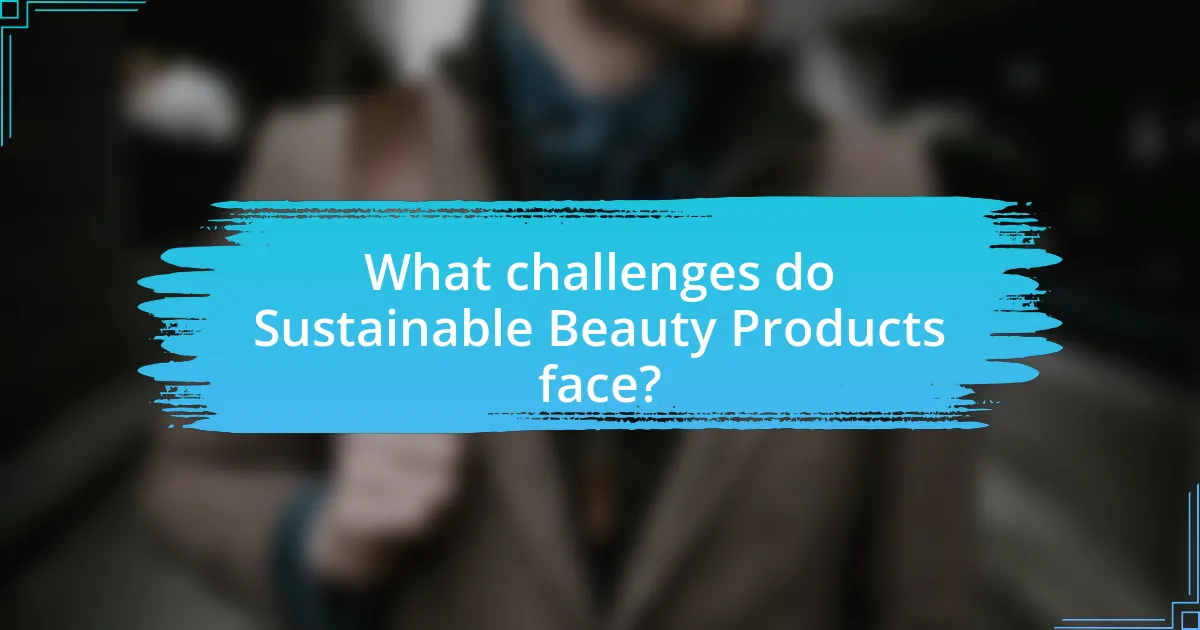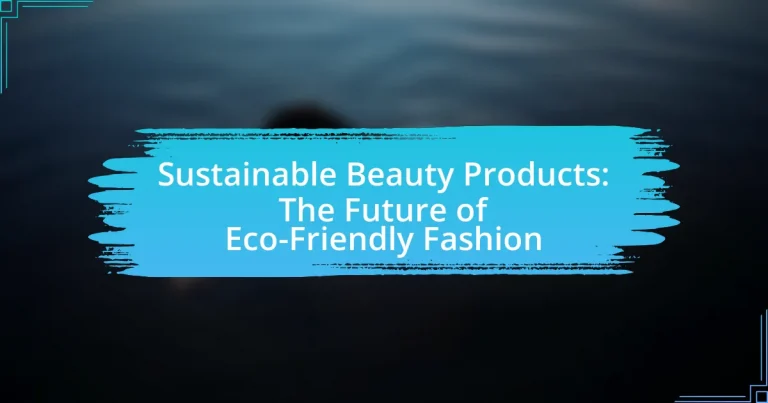Sustainable beauty products are cosmetics and personal care items designed to minimize environmental harm through the use of eco-friendly ingredients and packaging. This article explores the differences between sustainable and traditional beauty products, highlighting the use of natural, organic, and biodegradable materials, as well as ethical sourcing practices. It addresses the environmental issues these products aim to combat, such as plastic waste and chemical pollution, and examines consumer preferences driving the shift towards sustainability. Additionally, the article discusses key trends, innovations in packaging, and the challenges brands face in adopting sustainable practices, providing practical tips for consumers to support the sustainable beauty movement.

What are Sustainable Beauty Products?
Sustainable beauty products are cosmetics and personal care items made from environmentally friendly ingredients and packaging that minimize harm to the planet. These products often utilize natural, organic, or biodegradable materials, reducing reliance on synthetic chemicals and non-renewable resources. For instance, a report by the Environmental Working Group highlights that sustainable beauty products can significantly lower the carbon footprint associated with traditional beauty items, which often contain harmful chemicals and contribute to pollution.
How do Sustainable Beauty Products differ from traditional beauty products?
Sustainable beauty products differ from traditional beauty products primarily in their ingredients and production processes. Sustainable beauty products utilize natural, organic, and biodegradable ingredients, minimizing environmental impact, while traditional beauty products often contain synthetic chemicals and non-biodegradable materials. For instance, a study published in the Journal of Cleaner Production highlights that sustainable cosmetics can reduce carbon emissions by up to 50% compared to conventional products. Additionally, sustainable brands prioritize ethical sourcing and cruelty-free practices, contrasting with many traditional brands that may not adhere to these standards.
What materials are commonly used in Sustainable Beauty Products?
Sustainable beauty products commonly use materials such as organic plant extracts, biodegradable packaging, and natural oils. Organic plant extracts, derived from sustainably sourced botanicals, provide effective skincare benefits while minimizing environmental impact. Biodegradable packaging, made from materials like recycled paper or bioplastics, reduces waste in landfills. Natural oils, such as jojoba or argan oil, are favored for their nourishing properties and lower ecological footprint compared to synthetic alternatives. These materials collectively contribute to the eco-friendly ethos of sustainable beauty, aligning with consumer demand for environmentally responsible products.
How do production processes impact sustainability in beauty products?
Production processes significantly impact sustainability in beauty products by determining resource usage, waste generation, and environmental footprint. For instance, the extraction of raw materials, such as palm oil or minerals, can lead to deforestation and habitat destruction, contributing to biodiversity loss. Additionally, energy-intensive manufacturing processes often rely on fossil fuels, increasing greenhouse gas emissions. A study by the Ellen MacArthur Foundation highlights that the beauty industry could reduce its carbon footprint by 70% through sustainable sourcing and production methods. Furthermore, the use of biodegradable packaging and water-efficient processes can minimize waste and resource depletion, enhancing overall sustainability.
Why is sustainability important in the beauty industry?
Sustainability is important in the beauty industry because it addresses environmental concerns and promotes ethical practices. The beauty industry significantly contributes to pollution and waste, with an estimated 120 billion units of packaging produced annually, much of which is not recyclable. By adopting sustainable practices, brands can reduce their carbon footprint, minimize waste, and conserve natural resources, which is essential for combating climate change and preserving biodiversity. Furthermore, consumers increasingly demand transparency and responsibility from brands, with 73% of millennials willing to pay more for sustainable products, indicating a market shift towards eco-friendly options.
What environmental issues are addressed by Sustainable Beauty Products?
Sustainable beauty products address several environmental issues, including plastic waste, chemical pollution, and resource depletion. These products often utilize biodegradable packaging to reduce plastic pollution, which contributes significantly to ocean and landfills. Additionally, they typically avoid harmful chemicals that can contaminate water sources and harm ecosystems. For instance, the use of natural ingredients minimizes the ecological footprint associated with synthetic chemical production, which often involves resource-intensive processes. Furthermore, sustainable beauty brands frequently emphasize ethical sourcing of materials, which helps combat deforestation and promotes biodiversity.
How do consumer preferences influence the shift towards sustainability?
Consumer preferences significantly influence the shift towards sustainability by driving demand for eco-friendly products and practices. As consumers increasingly prioritize environmental concerns, brands are compelled to adopt sustainable practices to meet these expectations. For instance, a 2021 survey by McKinsey found that 67% of consumers consider sustainability when making purchasing decisions, indicating a strong market trend towards eco-conscious products. This shift prompts companies to innovate and offer sustainable beauty products, aligning their offerings with consumer values and preferences.

What are the key trends in Sustainable Beauty Products?
Key trends in sustainable beauty products include the rise of clean ingredients, eco-friendly packaging, and transparency in sourcing. Clean ingredients focus on eliminating harmful chemicals, with 70% of consumers preferring products free from synthetic additives. Eco-friendly packaging emphasizes recyclable or biodegradable materials, as 55% of consumers are willing to pay more for sustainable packaging. Transparency in sourcing involves brands disclosing ingredient origins and production processes, which 80% of consumers find important when making purchasing decisions. These trends reflect a growing consumer demand for environmentally responsible and health-conscious beauty options.
How are brands innovating in the sustainable beauty space?
Brands are innovating in the sustainable beauty space by developing eco-friendly formulations, utilizing biodegradable packaging, and implementing transparent supply chains. For instance, companies like Lush and Aveda focus on using natural ingredients and reducing plastic waste, with Lush offering solid shampoo bars that eliminate plastic bottles. Additionally, brands are adopting refillable packaging systems, as seen with Fenty Beauty, which encourages consumers to reuse containers. These innovations not only address environmental concerns but also cater to a growing consumer demand for sustainability, with a report from Grand View Research indicating that the global green beauty market is expected to reach $22 billion by 2024.
What role does packaging play in sustainable beauty innovations?
Packaging plays a crucial role in sustainable beauty innovations by minimizing environmental impact through the use of eco-friendly materials and designs. Sustainable packaging options, such as biodegradable, recyclable, or reusable materials, reduce waste and promote a circular economy in the beauty industry. For instance, brands like Lush utilize minimal packaging and encourage customers to bring back containers for recycling, demonstrating a commitment to sustainability. Additionally, studies show that consumers increasingly prefer products with sustainable packaging, influencing brands to innovate in this area to meet market demand and enhance brand loyalty.
How are natural ingredients being prioritized in product formulations?
Natural ingredients are being prioritized in product formulations through a significant shift towards sustainability and consumer demand for clean beauty. Brands are increasingly incorporating plant-based components, such as botanical extracts and essential oils, to enhance product efficacy while minimizing environmental impact. According to a 2021 survey by Statista, 62% of consumers prefer products with natural ingredients, indicating a clear market trend. This prioritization is further supported by regulatory changes and certifications that encourage the use of eco-friendly materials, reinforcing the commitment to sustainability in the beauty industry.
What certifications should consumers look for in Sustainable Beauty Products?
Consumers should look for certifications such as USDA Organic, EcoCert, and Leaping Bunny in sustainable beauty products. USDA Organic certification ensures that products are made from at least 95% organic ingredients, promoting environmentally friendly farming practices. EcoCert verifies that products meet strict environmental and social criteria, including sustainable sourcing and minimal environmental impact. Leaping Bunny certification guarantees that no animal testing is conducted at any stage of product development, aligning with ethical consumer values. These certifications provide assurance of the product’s sustainability and ethical standards.
What do eco-labels signify about a product’s sustainability?
Eco-labels signify that a product meets specific environmental and sustainability standards. These labels indicate that the product has undergone assessment and certification processes that evaluate its impact on the environment, including factors such as resource use, emissions, and waste management. For example, certifications like the Forest Stewardship Council (FSC) for paper products or the Global Organic Textile Standard (GOTS) for textiles provide consumers with assurance that the products are sourced and produced sustainably. This information helps consumers make informed choices that align with their values regarding environmental responsibility.
How can consumers verify the authenticity of sustainable claims?
Consumers can verify the authenticity of sustainable claims by checking for third-party certifications, researching the brand’s supply chain transparency, and examining the ingredient sourcing. Third-party certifications, such as Fair Trade, USDA Organic, or Global Organic Textile Standard, provide independent verification of a brand’s sustainability practices. Researching the brand’s supply chain transparency involves looking for detailed information on sourcing, production processes, and labor practices, which reputable brands often disclose on their websites. Additionally, examining ingredient sourcing can reveal whether materials are derived from sustainable sources, as brands committed to sustainability typically highlight eco-friendly ingredients and practices in their marketing.

What challenges do Sustainable Beauty Products face?
Sustainable beauty products face significant challenges, primarily related to sourcing, consumer perception, and regulatory compliance. Sourcing sustainable ingredients can be difficult due to limited availability and higher costs, which can impact product pricing and accessibility. Consumer perception often presents a hurdle, as many individuals may associate sustainable products with lower efficacy or higher prices, leading to hesitance in purchasing. Additionally, regulatory compliance poses challenges, as varying standards across regions can complicate the formulation and marketing of these products. For instance, the European Union has stringent regulations on cosmetic ingredients, which can limit the options available for sustainable formulations.
What are the common misconceptions about Sustainable Beauty Products?
Common misconceptions about sustainable beauty products include the belief that they are always more expensive, less effective, and only available from niche brands. Many consumers assume that sustainable products come with a higher price tag due to perceived premium ingredients or ethical sourcing; however, studies show that the price gap is narrowing as demand increases and production scales up. Additionally, some people think that sustainable beauty products do not perform as well as conventional options, but research indicates that many sustainable brands utilize innovative formulations that rival traditional products in effectiveness. Lastly, the notion that sustainable beauty is limited to small, independent brands is misleading, as major cosmetic companies are increasingly adopting sustainable practices and launching eco-friendly lines.
How do price points affect consumer adoption of sustainable products?
Price points significantly influence consumer adoption of sustainable products, as higher prices often deter potential buyers while lower prices can enhance accessibility. Research indicates that consumers are more likely to purchase sustainable products when they are priced competitively with conventional alternatives; for instance, a study published in the Journal of Consumer Research found that price sensitivity is a critical factor, with 70% of consumers stating they would buy more sustainable products if they were more affordable. Additionally, consumers perceive higher-priced sustainable products as premium, which can create a barrier for mass adoption, particularly among price-sensitive demographics.
What barriers exist for brands transitioning to sustainable practices?
Brands transitioning to sustainable practices face several barriers, including high costs, lack of consumer demand, and insufficient supply chain infrastructure. High costs associated with sourcing sustainable materials and implementing eco-friendly processes can deter brands from making the switch. Additionally, many consumers still prioritize price over sustainability, leading to lower demand for eco-friendly products. Furthermore, the existing supply chain infrastructure often lacks the necessary resources and technology to support sustainable practices, making it challenging for brands to adopt these changes effectively. According to a report by McKinsey & Company, 66% of consumers are willing to pay more for sustainable brands, indicating potential demand, but the current market dynamics still present significant hurdles for brands.
How can consumers support the sustainable beauty movement?
Consumers can support the sustainable beauty movement by choosing products from brands that prioritize eco-friendly practices and ingredients. By selecting beauty products that are certified organic, cruelty-free, and packaged in recyclable or biodegradable materials, consumers directly contribute to reducing environmental impact. Research indicates that the global organic beauty market is projected to reach $25.11 billion by 2025, reflecting a growing consumer preference for sustainable options. Additionally, supporting local and small-scale brands can further enhance sustainability, as these companies often utilize more responsible sourcing and production methods.
What are some practical tips for choosing sustainable beauty products?
To choose sustainable beauty products, prioritize items with eco-friendly packaging, natural ingredients, and ethical sourcing. Eco-friendly packaging reduces waste and often uses recyclable or biodegradable materials, while natural ingredients minimize environmental impact and potential harm to health. Ethical sourcing ensures that ingredients are obtained in a manner that respects both the environment and the communities involved in production. According to a 2021 report by the Environmental Working Group, products with fewer synthetic chemicals and transparent ingredient lists are generally safer and more sustainable.
How can consumers advocate for more sustainable practices in the beauty industry?
Consumers can advocate for more sustainable practices in the beauty industry by actively supporting brands that prioritize eco-friendly ingredients and packaging. By choosing products from companies that demonstrate transparency in their sourcing and manufacturing processes, consumers can influence market demand for sustainable options. Research indicates that 66% of global consumers are willing to pay more for sustainable brands, highlighting the financial incentive for companies to adopt greener practices. Additionally, consumers can engage in social media campaigns, sign petitions, and participate in community initiatives that promote sustainability, thereby amplifying their voices and encouraging industry-wide change.

















